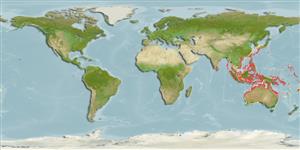Common names from other countries
>
Eupercaria/misc (Various families in series Eupercaria) >
Labridae (Wrasses)
Etymology: Labropsis: Greek, labrax, -akos = a fish, Dicentrarchus labrax + Greek,opsis = appearance (Ref. 45335).
Environment: milieu / climate zone / depth range / distribution range
Écologie
marin récifal; profondeur 5 - 30 m (Ref. 2137), usually 5 - 20 m (Ref. 27115). Tropical; 24°C - 27°C (Ref. 27115)
Indo-West Pacific: Western Australia (Scott Reef) to Papua New Guinea; north to Japan.
Taille / Poids / Âge
Maturity: Lm ? range ? - ? cm
Max length : 11.7 cm SL mâle / non sexé; (Ref. 2137)
Épines dorsales (Total) : 9; Rayons mous dorsaux (Total) : 11; Épines anales: 3; Rayons mous anaux: 10; Vertèbres: 25. Body of male orangish in life; large females similar in body color with males except for the absence of the large orange area beneath and around the pectoral fin base and the black spot on the dorsal fin. Inconspicuous stripes on head of females; juveniles and small females with 3 broad black stripes on head and body, separated by narrow pale blue stripes. Posterior caudal peduncle and fin principally dark brown or black. Juveniles nearly identical to juveniles of Diproctacanthus but have a longer dorsal fin (Ref. 48636).
Occurs solitary or in small groups (Ref. 90102) in rich coral reefs in clear coastal to outer reef habitats. Adults feed on coral polyps but may also clean (Ref. 48636). Minimum depth range from Ref. 27115.
Life cycle and mating behavior
Maturities | Reproduction | Spawnings | Egg(s) | Fecundities | Larves
Oviparous, distinct pairing during breeding (Ref. 205).
Randall, J.E., 1981. Revision of the labrid fish genus Labropsis with description of five new species. Micronesica 17(1-2):125-155. (Ref. 2137)
Statut dans la liste rouge de l'IUCN (Ref. 130435)
CITES (Ref. 128078)
Not Evaluated
Menace pour l'homme
Harmless
Utilisations par l'homme
Pêcheries: commercial; Aquarium: Commercial
Outils
Articles particuliers
Télécharger en XML
Sources Internet
Estimates based on models
Preferred temperature (Ref.
115969): 22.9 - 28.9, mean 27.8 (based on 532 cells).
Phylogenetic diversity index (Ref.
82804): PD
50 = 0.5156 [Uniqueness, from 0.5 = low to 2.0 = high].
Bayesian length-weight: a=0.00955 (0.00456 - 0.02002), b=3.06 (2.89 - 3.23), in cm Total Length, based on LWR estimates for this (Sub)family-body shape (Ref.
93245).
Niveau trophique (Ref.
69278): 3.3 ±0.61 se; based on food items.
Résilience (Ref.
120179): Haut, temps minimum de doublement de population inférieur à 15 mois (Preliminary K or Fecundity.).
Fishing Vulnerability (Ref.
59153): Low vulnerability (10 of 100).
